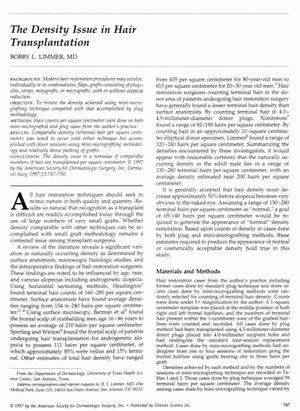TLDR Mini-micrografting in hair transplants can give similar density to older methods with fewer sessions.
In the 1997 study by Bobby L. Limmer, MD, it was found that mini-micrografting could achieve comparable hair density to the older plug method in hair transplantation, with the added benefit of requiring fewer sessions. Hair counts per square centimeter from the author's practice indicated that the average density for plug graft cases was 59 terminal hairs per square centimeter. In contrast, mini-micrografted cases showed an increase in density with the number of sessions: one session averaged 41 hairs, two sessions averaged 50 hairs, three sessions averaged 63 hairs, and four sessions averaged 81 hairs per square centimeter. The study concluded that the density issue is not significant as long as a comparable number of hairs are transplanted per square centimeter, and that mini-micrografting is a more efficient technique in terms of sessions needed.
 42 citations
,
December 1990 in “The Journal of Dermatologic Surgery and Oncology”
42 citations
,
December 1990 in “The Journal of Dermatologic Surgery and Oncology” The study found that horizontal sections of scalp biopsies are better for analyzing hair loss, showing fewer hairs and more fine hairs in balding areas.
 5 citations
,
July 1999 in “Plastic and Reconstructive Surgery”
5 citations
,
July 1999 in “Plastic and Reconstructive Surgery” Unsatisfactory hair restoration results can be significantly improved with strategic hair redistribution and new donor hair placement, despite previous surgery challenges.
 5 citations
,
September 2003 in “Archives of Facial Plastic Surgery”
5 citations
,
September 2003 in “Archives of Facial Plastic Surgery” Follicular-unit grafting is an effective hair transplant method that looks natural and has a high success rate.
 77 citations
,
April 1999 in “Dermatologic Clinics”
77 citations
,
April 1999 in “Dermatologic Clinics” The document concludes that follicular unit transplantation offers more natural results and better graft survival than older hair transplant methods.
 January 2016 in “Springer eBooks”
January 2016 in “Springer eBooks” The document concludes that there are various causes and treatments for hair loss, with hair transplantation being a notable option.
 4 citations
,
January 2005 in “Elsevier eBooks”
4 citations
,
January 2005 in “Elsevier eBooks” Follicular Unit Transplantation is a precise hair restoration technique that requires careful planning and a skilled team, and Follicular Unit Extraction offers a less invasive option.







